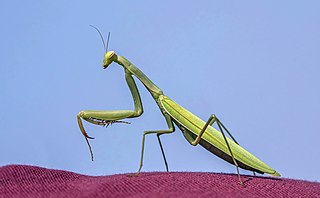
Moths are a group of insects that includes all members of the order Lepidoptera that are not butterflies. They were previously classified as suborder Heterocera, but the group is paraphyletic with respect to butterflies and neither subordinate taxon is used in modern classifications. Moths make up the vast majority of the order. There are approximately 160,000 species of moth, many of which have yet to be described. Most species of moth are nocturnal, although there are also crepuscular and diurnal species.

Okeechobee is a city in and the county seat of Okeechobee County, Florida, United States. As of the 2020 US census, the city's population was 5,254.

Pitcher plants are carnivorous plants known as pitfall traps—a prey-trapping mechanism featuring a deep cavity filled with digestive liquid. The traps of pitcher plant are considered to be "true" pitcher plants and are formed by specialized leaves. The plants attract and drown the prey with nectar.

The boll weevil is a species of beetle in the family Curculionidae. The boll weevil feeds on cotton buds and flowers. Thought to be native to Central Mexico, it migrated into the United States from Mexico in the late 19th century and had infested all U.S. cotton-growing areas by the 1920s, devastating the industry and the people working in the American South. During the late 20th century, it became a serious pest in South America as well. Since 1978, the Boll Weevil Eradication Program in the U.S. allowed full-scale cultivation to resume in many regions.

Earwigs make up the insect order Dermaptera. With about 2,000 species in 12 families, they are one of the smaller insect orders. Earwigs have characteristic cerci, a pair of forceps-like pincers on their abdomen, and membranous wings folded underneath short, rarely used forewings, hence the scientific order name, "skin wings". Some groups are tiny parasites on mammals and lack the typical pincers. Earwigs are found on all continents except Antarctica.

The Pholcidae are a family of araneomorph spiders. The family contains more than 1,800 individual species of pholcids, including those commonly known as cellar spider, daddy long-legs spider, carpenter spider, daddy long-legger, vibrating spider, gyrating spider, long daddy, skull spider, and angel spider. The family, first described by Carl Ludwig Koch in 1850, is divided into 94 genera.

Thomas Say was an American entomologist, conchologist, and herpetologist. His studies of insects and shells, numerous contributions to scientific journals, and scientific expeditions to Florida, Georgia, the Rocky Mountains, Mexico, and elsewhere made him an internationally known naturalist. Say has been called the father of American descriptive entomology and American conchology. He served as librarian for the Academy of Natural Sciences of Philadelphia, curator at the American Philosophical Society, and professor of natural history at the University of Pennsylvania.

Leafhopper is the common name for any species from the family Cicadellidae. These minute insects, colloquially known as hoppers, are plant feeders that suck plant sap from grass, shrubs, or trees. Their hind legs are modified for jumping, and are covered with hairs that facilitate the spreading of a secretion over their bodies that acts as a water repellent and carrier of pheromones. They undergo a partial metamorphosis, and have various host associations, varying from very generalized to very specific. Some species have a cosmopolitan distribution, or occur throughout the temperate and tropical regions. Some are pests or vectors of plant viruses and phytoplasmas. The family is distributed all over the world, and constitutes the second-largest hemipteran family, with at least 20,000 described species.

Darlingtonia State Natural Site is a state park and botanical preserve located five miles (8.0 km) north of Florence, Oregon, United States on U.S. Route 101, just west of Mercer Lake and south of Sutton Lake that is dedicated to the preservation of a rare plant.

The prothorax is the foremost of the three segments in the thorax of an insect, and bears the first pair of legs. Its principal sclerites are the pronotum (dorsal), the prosternum (ventral), and the propleuron (lateral) on each side. The prothorax never bears wings in extant insects, though some fossil groups possessed wing-like projections. All adult insects possess legs on the prothorax, though in a few groups the forelegs are greatly reduced. In many groups of insects, the pronotum is reduced in size, but in a few it is hypertrophied, such as in all beetles (Coleoptera). In most treehoppers, the pronotum is expanded into often fantastic shapes that enhance their camouflage or mimicry. Similarly, in the Tetrigidae, the pronotum is extended backward to cover the flight wings, supplanting the function of the tegmina.

Rhagionidae or snipe flies are a small family of flies. They get their name from the similarity of their often prominent proboscis that looks like the beak of a snipe.
Curtis Williams Sabrosky was an American entomologist. He specialized in Diptera, especially Chloropidae. Sabrosky worked at the Systematic Entomology Laboratory of United States Department of Agriculture and at the National Museum of Natural History, where his collection is now located.

Nepeta cataria, commonly known as catnip, catswort, catwort, and catmint, is a species of the genus Nepeta in the family Lamiaceae, native to southern and eastern Europe, the Middle East, Central Asia, parts of Mongolia, and parts of China. It is widely naturalized in northern Europe, New Zealand, and North America. The common name catmint can also refer to the genus as a whole.
Curalium is a genus of true bug that is the sole member of the insect family Curaliidae. Curalium contains a single species, Curalium cronini.

Mantises are an order (Mantodea) of insects that contains over 2,400 species in about 460 genera in 33 families. The largest family is the Mantidae ("mantids"). Mantises are distributed worldwide in temperate and tropical habitats. They have triangular heads with bulging eyes supported on flexible necks. Their elongated bodies may or may not have wings, but all Mantodea have forelegs that are greatly enlarged and adapted for catching and gripping prey; their upright posture, while remaining stationary with forearms folded, has led to the common name praying mantis.

Diflubenzuron is an insecticide of the benzoylurea class. It is used in forest management and on field crops to selectively control insect pests, particularly forest tent caterpillar moths, boll weevils, gypsy moths, and other types of moths. It is a widely used larvicide in India for control of mosquito larvae by public health authorities. Diflubenzuron is approved by the WHO Pesticide Evaluation Scheme.
Phoenicococcidae is a family of scale insects commonly known as palm scales or phoenicococcids. There is a single genus containing one species, Phoenicococcus marlatti.

Charles Henry Tyler Townsend was an American entomologist specializing in the study of tachinids (Tachinidae), a large and diverse family of flies (Diptera) with larvae that are parasitoids of other insects. He was perhaps the most prolific publisher of new tachinids, naming and describing some 3000 species and genera. He made important contributions to the biological control of insect pests and he was the first to identify the insect vector of a debilitating disease in Peru. Townsend was also a controversial figure and criticism of his approach to insect taxonomy continues to this day.

John Merton Aldrich was an American entomologist. Aldrich was the Associate Curator of Insects at the United States National Museum. He is considered one of the most prolific entomologists in the study of flies.

Tettigoniidea is an infraorder of the order Orthoptera, with six extant families.

















